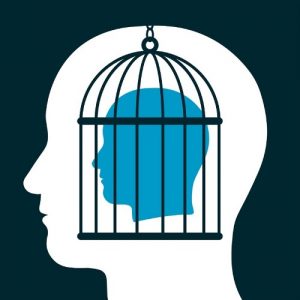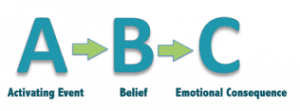What is self-talk?

- Self-talk is the running dialogue you have with yourself
- Self-talk can be purposeful or random
- Self-talk can be an internal or external dialogue
- Positive self-talk most often results in good performance
- Negative self-talk ALWAYS results in poor performance
Why is self-talk important for students?
Self-talk influences your academic performance and your well-being. Controlling your thoughts is the gateway to controlling your emotions and behaviors.
How can positive self-talk help you?
- Regulate your emotions
- Work more efficiently
- Increase your self-esteem
- Increase your self-confidence
- Control your thoughts, feelings and behaviors
- Attain your goals
How can you improve your self-talk?

- Monitor your self-talk – become aware of your thought patterns
- Eliminate negative self-talk – dispute your negative thoughts with evidence & replace your negative self-talk with positive, more realistic thoughts
Thinking Traps
Your self-talk can be a reflection of thinking traps or cognitive distortions. Thinking patterns are overly rigid ways of thinking that can cause individuals to miss certain cues or information about a situation. Thinking traps are common, especially in stressful situations. Listed below are different thinking traps or cognitive distortions. Do you identify with any of these thinking traps?
- Perfection is Essential – The belief that one must thoroughly competent, successful, and can never fail. There is value in striving for perfection, but nothing is gained by demanding perfection.
- Externalization of Self Worth – The development and maintenance of self-worth is based almost exclusively on how the external world views you. You may feel that your worth depends on your achievement in school.
- Comparison – The tendency to compare oneself with others. The outcome typically results in the conclusion that one is inferior or worse off than others.
- Disqualify the Positive – The process of discounting positive experiences, traits, or attributes.
- Fortune Telling – The process of predicting a negative outcome of a future event by believing this prediction is absolutely true for you. For example, ” I am going to fail my midterm!”
- Mind Reading – An arbitrary conclusion that someone is reacting negatively or thinking negatively toward you without specific evidence to support that conclusion.

- Black/White Thinking – The tendency to view all experiences as fitting into one of two categories (e.g. positive or negative; good or bad) without the ability to place oneself, others, and experiences along a continuum.
- Magnification – The tendency to exaggerate or magnify either the positive or negative importance or consequence of some personal trait, event, or circumstance (i.e., a so-so test performance).
- Over-Generalization – The process of formulating rules or conclusions on the basis of limited experienced and applying these rules across broad and unrelated situations.
- Emotional Reasoning – The predominant use of an emotional state to form conclusions about oneself, others, or situations.
- Jumping to Conclusions – Process of drawing a negative conclusion, in the absence of specific evidence to support that conclusion.
- Selective Abstractions – The process of exclusively focusing on one negative aspect or detail of a situation, magnifying the importance of that detail, thereby casting the whole situation in a negative context.
- Should Statements – The process of applying personal standards of behavior, standards for other people, or standards about the way the world functions in all situations. Involves use of words like “should,” “ought,” and “must.”
- Personalization – The process of assuming personal causality for situations, events, and reactions of others when there is no evidence supporting that conclusion.
Identify which thinking traps you might fall into. If you fall into a thinking trap, complete the thinking traps worksheet to help – Thinking Traps Worksheet
ABC’s of Self-Talk
The ABC’s, a model created by Albert Ellis, is a way to identify, address, and change irrational thoughts or thinking patterns. This model can help you restructure unhealthy beliefs. Maybe these beliefs are caused by one of the thinking traps listed above.

- A stands for activating event. Any activating event can be anything…a car accident, a low score on an exam, or a conversation with a friend.
- B stands for belief. The belief about the activating event and the belief about yourself. According to Ellis, your beliefs about the activating event can be either rational or irrational. Your self-talk is a reflection of your beliefs. Irrational beliefs and the resulting self-talk could include statements like “I am a terrible student,” “Everyone else is so much smarter than me,” or “I should drop out” after receiving a poor score on an exam.
- C stands for consequence. The consequences are your emotional and behavioral reactions resulting from the belief. When the belief about your test score is irrational, the consequences could include feelings of sadness, withdrawal, decreased effort, feelings of self-defeat, anger, or decreased confidence.
- D stands for dispute. In order to think in a more healthy and productive way, you must dispute your irrational beliefs. In a sense, you must argue with yourself. It takes time and practice to recognize how your irrational beliefs negatively affect you and how you can stop them. But there is good news – you can learn to dispute these thoughts and replace with them with more rational and helpful beliefs about the activating event. To start, ask yourself the questions below and take notes on your answers. As you do this, begin to form counterarguments for your unhealthy beliefs.
- Are these thoughts helpful or hurtful?
- What factual evidence support this claim? Is there factual evidence that does not support the claim I made? (e.g. I scored a 90% on the last 3 exams)
- is this belief based on objective reality?
- What would a friend say to you?
- Is this belief logical?
- Do these thoughts help me reach my short and long term goals?
- Example of new beliefs: “I am a good student. That test did not reflect my knowledge about the subject,” “Hey, a 70% is a passing score,” or “I will continue to learn and grow” are examples of disputed beliefs following a so-so exam score.
- E stands for effect. The effect is the consequence of the new belief. Your new belief will create a completely different set of behavioral and emotional consequences. Increased self-confidence, enhanced motivation, and heightened effort are examples of new effects.
The following worksheet provides an example of how the ABC’s work – ABC’s of Cognitive Restructuring Worksheet
Articles on Self-Talk
- Challenging Negative Self-Talk
- How Self-Talk Can Help Accomplish Goals
- Positive Self-Talk Leads to Success
Self-Talk Videos
This video discusses the power of positive self-talk.
This video discusses getting stuck in the negative and how to get unstuck.
This video discusses what automatic thoughts are.

